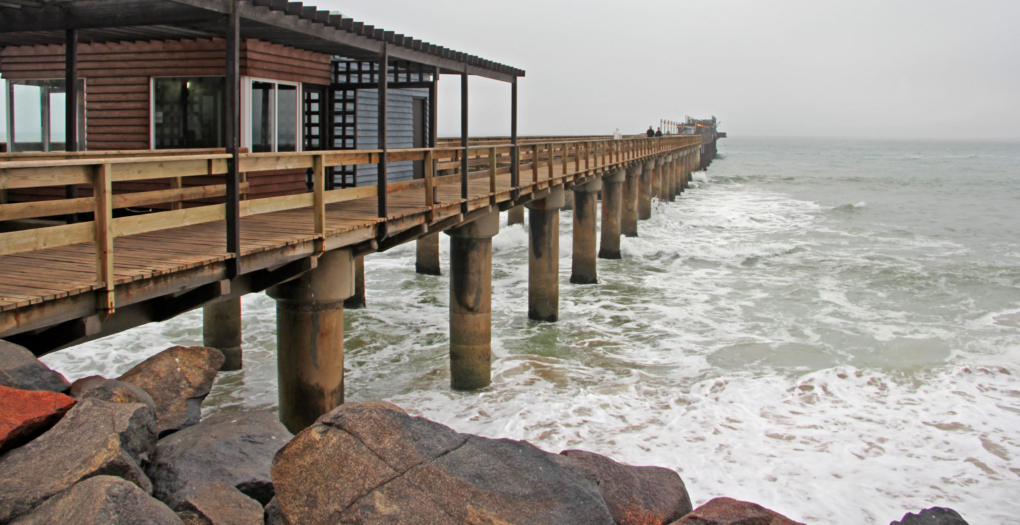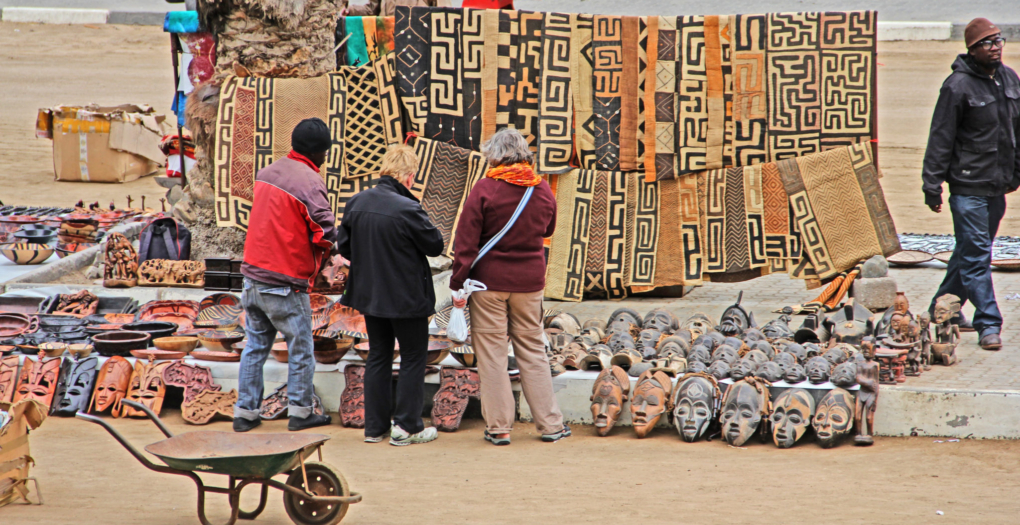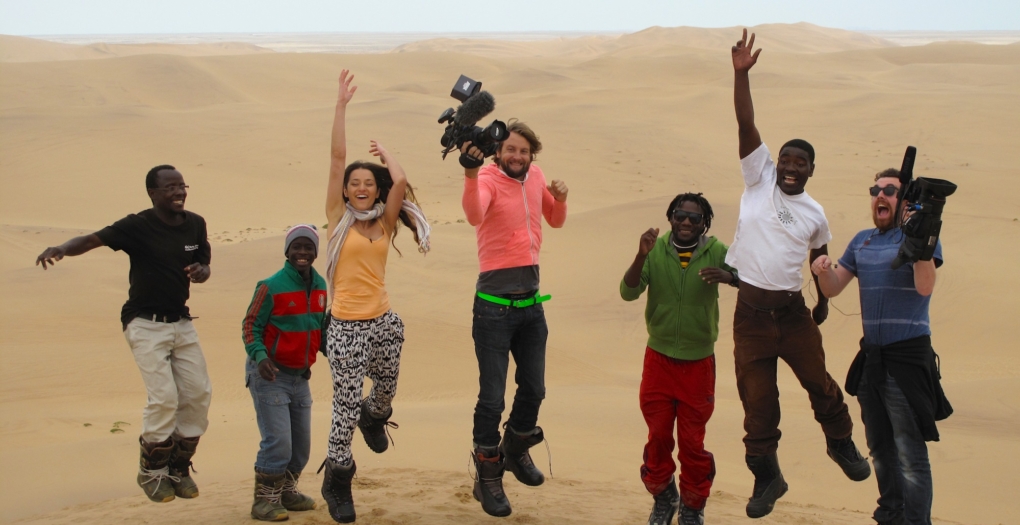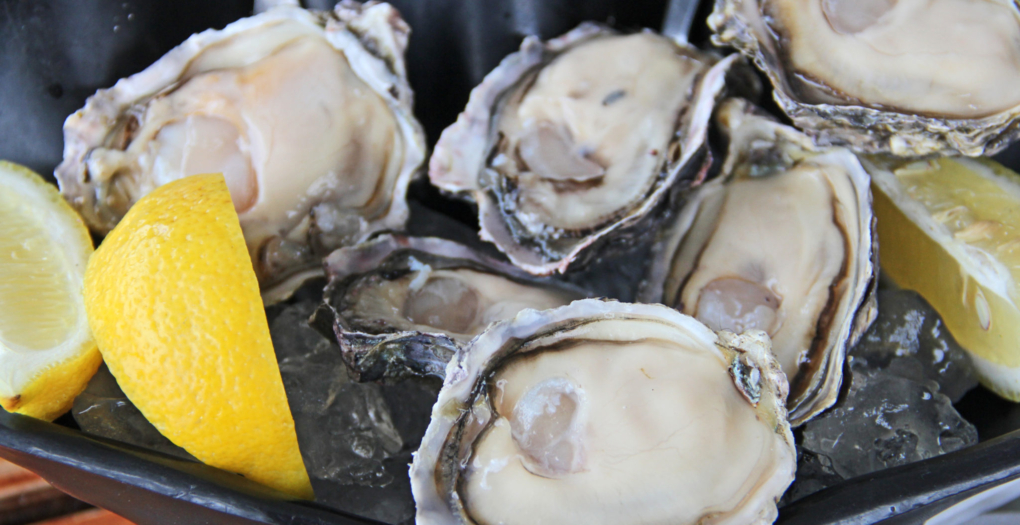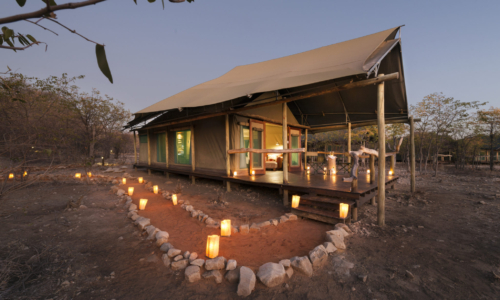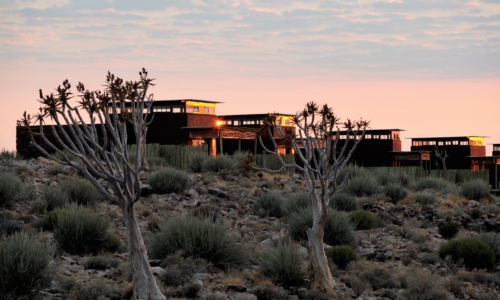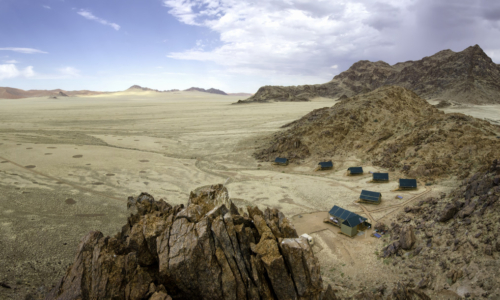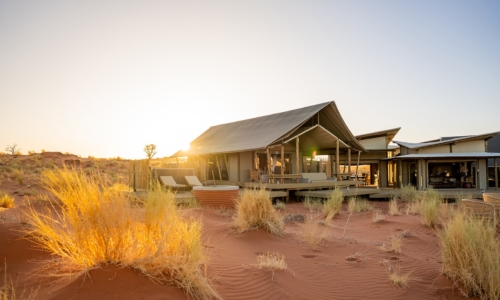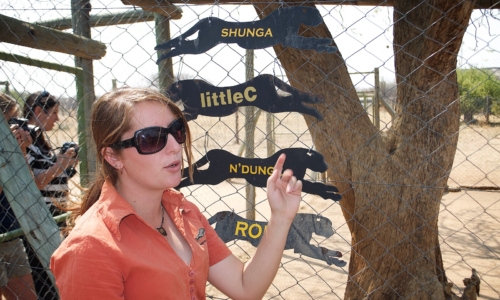In 1892, a German captain founded Swakopmund as the main harbor for Germany in the African colony. Subsequently, it was used for importing and exporting large amounts of goods from other parts of the continent. In 1915, with the union of South Africa, much of the harbor activities were transferred to Walvis Bay. Later in 1990, when Namibia declared its independence from South Africa, many street names were changed from German or Afrikaans names to those honoring native Namibians. However, with business and commerce diminishing, city officials realized that Swakopmund was ideally situated to offer an exceptional resort experience for world travelers.
The city still echoes with its German colonial past which is most evident in its architecture, place names, and even language with many German-speaking citizens still residing in the area. Some of the original colonial sites still stand as monuments and museums of the past. Visitors can indulge in a city tour to take in the Woermannhaus with its attractive tower, the Kaiserliches Bezirksgericht State House which was once the home of the territorial administrator and is now the official city residence of the president, or the Deutsche Evangelisch-Lutherische Church. Of course, there are plenty of other historical museums and sites to visit too including the Swakopmund Museum, the National Marine Aquarium, and the Kristall Galerie where the largest quartz crystal has ever been found.
Though Swakopmund’s German heritage might actually be best preserved in its world-class German beer breweries and restaurants. Yet even with its colonial heritage, the city still feels very African and can be best felt in a tour of the township of Mondesa.
Ideally situated between the Atlantic with its fascinating Skeleton Coast of wrecked ships and the high dunes of the Namib Desert, Swakopmund is known as the adventure capital of Namibia. The sand dunes tempt adrenaline junkies interested in quad bike treks, sand boarding, and tracking chameleons, Palmato geckos, sidewinders, scorpions, and sand-diving lizards. While the Atlantic Ocean offers plenty of dolphin and seal cruises on beautiful catamarans, fly fishing excursions, and whale watching tours. Of course, there are also the typical holiday activities like sunbathing, beachcombing, skydiving, and chartering private cruises.
Outside the city, visitors can explore a camel farm, an abandoned steam locomotive dating from 1896, and the Rossmund Desert Golf Course, one of only five all-grass desert golf courses in the world. For a unique experience, sightseers can tour the Namib’s ancient canyons in the Moon Valley and its unusual thousand year old Welwitschia mirabilis plants with their ribbon-like stalks.

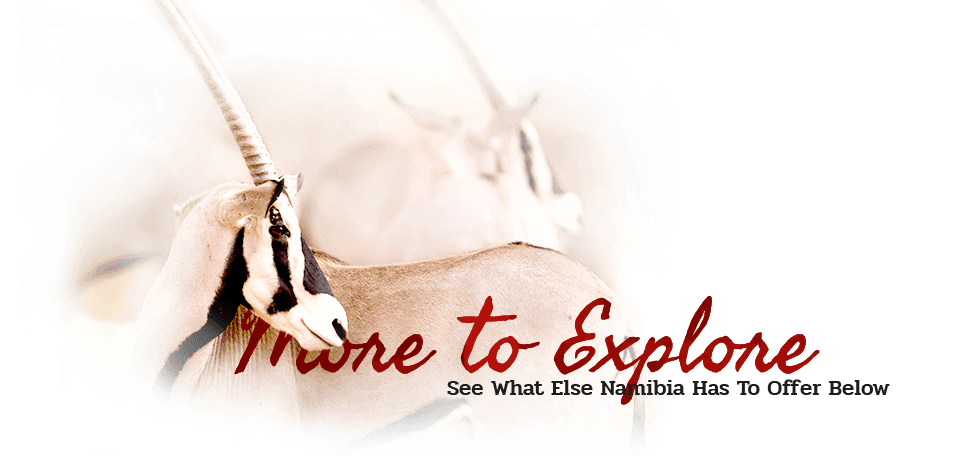
- Anderssons at Ongava
- Babson House
- Camp Kipwe
- Canyon Lodge
- Canyon Roadhouse
- Canyon Village
- Cape Cross Lodge
- Chobe Savanna Lodge
- Damara Mopane Lodge
- Damaraland Camp
- Dead Valley Lodge
- Desert Hills Glamping Camp
- Desert Homestead
- Desert Homestead Outpost
- Desert Rhino Camp
- Dolomite Camp
- Doro Nawas Camp
- Eagle’s Nest Lodge
- Erongo Wilderness Lodge
- Etosha Heights Safari House
- Etosha Mountain Lodge
- Etosha Safari Camp
- Etosha Safari Lodge
- Fish River Lodge
- Fort Sesfontein Lodge
- Grootberg Lodge
- Halali Camp
- Hoanib Elephant Camp
- Hoanib Skeleton Coast Camp
- Hoanib Valley Camp
- Ichingo Chobe River Lodge
- Kalahari Anib Lodge
- Kalahari Farmhouse
- Khorixas Rest Camp
- Kulala Desert Lodge
- Kwessi Dunes
- Little Kulala
- Little Ongava
- Malansrus Tented Camp
- Mowani Mountain Camp
- Mushara Bush Camp
- Mushara Lodge
- Mushara Outpost
- Naankuse Lodge
- Namib Desert Lodge
- Namushasha River Lodge
- Namutoni Camp
- Nhoma Safari Camp
- Nkasa Linyanti
- Okahirongo Elephant Lodge
- Okahirongo River Camp
- Okaukuejo Camp
- Okonjima Bush Camp
- Okonjima Bush Suite
- Okonjima Grand African Villa
- Okonjima Plains Camp
- Onduli Ridge
- Ongava Lodge
- Ongava Tented Camp
- Onguma Bush Camp
- Onguma Etosha Aoba Lodge
- Onguma Tented Camp
- Onguma The Fort
- Onguma Tree Top Camp
- Onkoshi Camp
- Ozondjou Trails
- Popa Falls Camp
- River Crossing Lodge
- Safarihoek Lodge
- Serra Cafema Camp
- Shipwreck Lodge
- Sossus Dune Lodge
- Sossusvlei Desert Lodge
- Terrace Bay Camp
- Teufelskrallen Tented Lodge
- Villa Mushara
- Wolwedans Boulders Camp
- Wolwedans Desert Lodge
- Wolwedans Dune Camp
- Wolwedans Mountain View Suite
- Wolwedans Plains Camp
- Anderssons at Ongava
- Babson House
- Camp Kipwe
- Canyon Lodge
- Canyon Roadhouse
- Canyon Village
- Cape Cross Lodge
- Chobe Savanna Lodge
- Damara Mopane Lodge
- Damaraland Camp
- Dead Valley Lodge
- Desert Hills Glamping Camp
- Desert Homestead
- Desert Homestead Outpost
- Desert Rhino Camp
- Dolomite Camp
- Doro Nawas Camp
- Eagle’s Nest Lodge
- Erongo Wilderness Lodge
- Etosha Heights Safari House
- Etosha Mountain Lodge
- Etosha Safari Camp
- Etosha Safari Lodge
- Fish River Lodge
- Fort Sesfontein Lodge
- Grootberg Lodge
- Halali Camp
- Hoanib Elephant Camp
- Hoanib Skeleton Coast Camp
- Hoanib Valley Camp
- Ichingo Chobe River Lodge
- Kalahari Anib Lodge
- Kalahari Farmhouse
- Khorixas Rest Camp
- Kulala Desert Lodge
- Kwessi Dunes
- Little Kulala
- Little Ongava
- Malansrus Tented Camp
- Mowani Mountain Camp
- Mushara Bush Camp
- Mushara Lodge
- Mushara Outpost
- Naankuse Lodge
- Namib Desert Lodge
- Namushasha River Lodge
- Namutoni Camp
- Nhoma Safari Camp
- Nkasa Linyanti
- Okahirongo Elephant Lodge
- Okahirongo River Camp
- Okaukuejo Camp
- Okonjima Bush Camp
- Okonjima Bush Suite
- Okonjima Grand African Villa
- Okonjima Plains Camp
- Onduli Ridge
- Ongava Lodge
- Ongava Tented Camp
- Onguma Bush Camp
- Onguma Etosha Aoba Lodge
- Onguma Tented Camp
- Onguma The Fort
- Onguma Tree Top Camp
- Onkoshi Camp
- Ozondjou Trails
- Popa Falls Camp
- River Crossing Lodge
- Safarihoek Lodge
- Serra Cafema Camp
- Shipwreck Lodge
- Sossus Dune Lodge
- Sossusvlei Desert Lodge
- Terrace Bay Camp
- Teufelskrallen Tented Lodge
- Villa Mushara
- Wolwedans Boulders Camp
- Wolwedans Desert Lodge
- Wolwedans Dune Camp
- Wolwedans Mountain View Suite
- Wolwedans Plains Camp

In 1892, a German captain founded Swakopmund as the main harbor for Germany in the African colony. Subsequently, it was used for importing and exporting large amounts of goods from other parts of the continent. In 1915, with the union of South Africa, much of the harbor activities were transferred to Walvis Bay. Later in 1990, when Namibia declared its independence from South Africa, many street names were changed from German or Afrikaans names to those honoring native Namibians. However, with business and commerce diminishing, city officials realized that Swakopmund was ideally situated to offer an exceptional resort experience for world travelers.
The city still echoes with its German colonial past which is most evident in its architecture, place names, and even language with many German-speaking citizens still residing in the area. Some of the original colonial sites still stand as monuments and museums of the past. Visitors can indulge in a city tour to take in the Woermannhaus with its attractive tower, the Kaiserliches Bezirksgericht State House which was once the home of the territorial administrator and is now the official city residence of the president, or the Deutsche Evangelisch-Lutherische Church. Of course, there are plenty of other historical museums and sites to visit too including the Swakopmund Museum, the National Marine Aquarium, and the Kristall Galerie where the largest quartz crystal has ever been found.
Though Swakopmund’s German heritage might actually be best preserved in its world-class German beer breweries and restaurants. Yet even with its colonial heritage, the city still feels very African and can be best felt in a tour of the township of Mondesa.
Ideally situated between the Atlantic with its fascinating Skeleton Coast of wrecked ships and the high dunes of the Namib Desert, Swakopmund is known as the adventure capital of Namibia. The sand dunes tempt adrenaline junkies interested in quad bike treks, sand boarding, and tracking chameleons, Palmato geckos, sidewinders, scorpions, and sand-diving lizards. While the Atlantic Ocean offers plenty of dolphin and seal cruises on beautiful catamarans, fly fishing excursions, and whale watching tours. Of course, there are also the typical holiday activities like sunbathing, beachcombing, skydiving, and chartering private cruises.
Outside the city, visitors can explore a camel farm, an abandoned steam locomotive dating from 1896, and the Rossmund Desert Golf Course, one of only five all-grass desert golf courses in the world. For a unique experience, sightseers can tour the Namib’s ancient canyons in the Moon Valley and its unusual thousand year old Welwitschia mirabilis plants with their ribbon-like stalks.

- Anderssons at Ongava
- Babson House
- Camp Kipwe
- Canyon Lodge
- Canyon Roadhouse
- Canyon Village
- Cape Cross Lodge
- Chobe Savanna Lodge
- Damara Mopane Lodge
- Damaraland Camp
- Dead Valley Lodge
- Desert Hills Glamping Camp
- Desert Homestead
- Desert Homestead Outpost
- Desert Rhino Camp
- Dolomite Camp
- Doro Nawas Camp
- Eagle’s Nest Lodge
- Erongo Wilderness Lodge
- Etosha Heights Safari House
- Etosha Mountain Lodge
- Etosha Safari Camp
- Etosha Safari Lodge
- Fish River Lodge
- Fort Sesfontein Lodge
- Grootberg Lodge
- Halali Camp
- Hoanib Elephant Camp
- Hoanib Skeleton Coast Camp
- Hoanib Valley Camp
- Ichingo Chobe River Lodge
- Kalahari Anib Lodge
- Kalahari Farmhouse
- Khorixas Rest Camp
- Kulala Desert Lodge
- Kwessi Dunes
- Little Kulala
- Little Ongava
- Malansrus Tented Camp
- Mowani Mountain Camp
- Mushara Bush Camp
- Mushara Lodge
- Mushara Outpost
- Naankuse Lodge
- Namib Desert Lodge
- Namushasha River Lodge
- Namutoni Camp
- Nhoma Safari Camp
- Nkasa Linyanti
- Okahirongo Elephant Lodge
- Okahirongo River Camp
- Okaukuejo Camp
- Okonjima Bush Camp
- Okonjima Bush Suite
- Okonjima Grand African Villa
- Okonjima Plains Camp
- Onduli Ridge
- Ongava Lodge
- Ongava Tented Camp
- Onguma Bush Camp
- Onguma Etosha Aoba Lodge
- Onguma Tented Camp
- Onguma The Fort
- Onguma Tree Top Camp
- Onkoshi Camp
- Ozondjou Trails
- Popa Falls Camp
- River Crossing Lodge
- Safarihoek Lodge
- Serra Cafema Camp
- Shipwreck Lodge
- Sossus Dune Lodge
- Sossusvlei Desert Lodge
- Terrace Bay Camp
- Teufelskrallen Tented Lodge
- Villa Mushara
- Wolwedans Boulders Camp
- Wolwedans Desert Lodge
- Wolwedans Dune Camp
- Wolwedans Mountain View Suite
- Wolwedans Plains Camp
- Anderssons at Ongava
- Babson House
- Camp Kipwe
- Canyon Lodge
- Canyon Roadhouse
- Canyon Village
- Cape Cross Lodge
- Chobe Savanna Lodge
- Damara Mopane Lodge
- Damaraland Camp
- Dead Valley Lodge
- Desert Hills Glamping Camp
- Desert Homestead
- Desert Homestead Outpost
- Desert Rhino Camp
- Dolomite Camp
- Doro Nawas Camp
- Eagle’s Nest Lodge
- Erongo Wilderness Lodge
- Etosha Heights Safari House
- Etosha Mountain Lodge
- Etosha Safari Camp
- Etosha Safari Lodge
- Fish River Lodge
- Fort Sesfontein Lodge
- Grootberg Lodge
- Halali Camp
- Hoanib Elephant Camp
- Hoanib Skeleton Coast Camp
- Hoanib Valley Camp
- Ichingo Chobe River Lodge
- Kalahari Anib Lodge
- Kalahari Farmhouse
- Khorixas Rest Camp
- Kulala Desert Lodge
- Kwessi Dunes
- Little Kulala
- Little Ongava
- Malansrus Tented Camp
- Mowani Mountain Camp
- Mushara Bush Camp
- Mushara Lodge
- Mushara Outpost
- Naankuse Lodge
- Namib Desert Lodge
- Namushasha River Lodge
- Namutoni Camp
- Nhoma Safari Camp
- Nkasa Linyanti
- Okahirongo Elephant Lodge
- Okahirongo River Camp
- Okaukuejo Camp
- Okonjima Bush Camp
- Okonjima Bush Suite
- Okonjima Grand African Villa
- Okonjima Plains Camp
- Onduli Ridge
- Ongava Lodge
- Ongava Tented Camp
- Onguma Bush Camp
- Onguma Etosha Aoba Lodge
- Onguma Tented Camp
- Onguma The Fort
- Onguma Tree Top Camp
- Onkoshi Camp
- Ozondjou Trails
- Popa Falls Camp
- River Crossing Lodge
- Safarihoek Lodge
- Serra Cafema Camp
- Shipwreck Lodge
- Sossus Dune Lodge
- Sossusvlei Desert Lodge
- Terrace Bay Camp
- Teufelskrallen Tented Lodge
- Villa Mushara
- Wolwedans Boulders Camp
- Wolwedans Desert Lodge
- Wolwedans Dune Camp
- Wolwedans Mountain View Suite
- Wolwedans Plains Camp







